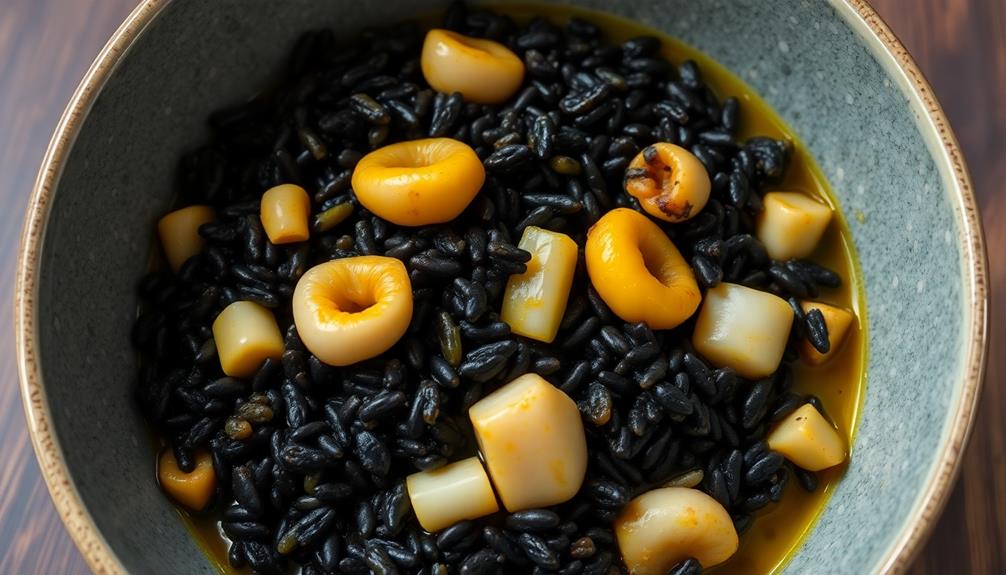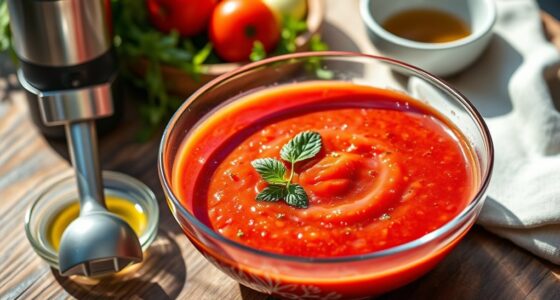Dive into the captivating history of Russian salad, a cherished dish that originated among the aristocracy of Imperial Russia. This iconic blend of boiled vegetables, meat, and creamy mayonnaise dressing has evolved over time, often featuring potatoes, carrots, peas, and either chicken or ham. While the Soviet era simplified the recipe, Russian salad remains a staple at festive gatherings, showcasing its versatility as a side, main course, or appetizer. With its vibrant colors, refreshing flavors, and cultural significance, this salad continues to enchant food enthusiasts worldwide, offering a delightful taste experience that's sure to delight your palate.
Key Takeaways
- Russian Salad, also known as Olivier Salad, originated in the late 19th century among the aristocracy of Imperial Russia and was created by chef Lucien Olivier.
- The traditional recipe includes boiled vegetables, meat, fish, and mayonnaise, though it was simplified during the Soviet era to exclude expensive ingredients.
- The common base of the salad includes boiled potatoes, carrots, and peas, with core ingredients often including chicken or ham, and boiled eggs.
- Russian Salad is a versatile dish that can be served as a side, main course, or appetizer, and is popular for festive occasions and family gatherings.
- The dish represents a fusion of culinary traditions and is widely popular in Eastern European and Central Asian cuisines, often featuring as a staple at potlucks and family gatherings.
History
The origins of Russian Salad can be traced back to the late 19th century, when it emerged as a popular dish among the aristocracy of Imperial Russia.
The salad, also known as "Olivier Salad," was created by Lucien Olivier, the renowned chef of the Hermitage, a famous Moscow restaurant. Olivier's original recipe combined boiled vegetables, meat, fish, and a rich mayonnaise dressing, creating a flavorful and visually appealing dish.
As the popularity of Russian Salad grew, it spread beyond the elite circles and became a staple at Russian celebrations and gatherings.
During the Soviet era, the recipe was simplified, often excluding expensive ingredients like caviar, but it remained a beloved part of the national cuisine.
Today, Russian Salad can be found in restaurants and homes across Russia, with each family adding their own unique twist to the classic dish.
Whether enjoyed as a side or a main course, this versatile salad continues to hold a special place in the hearts and stomachs of Russians worldwide.
Recipe
Russian salad, also known as Olivier salad, is a classic dish that originated in Russia in the 19th century. It's a delightful blend of cooked vegetables, meat, and a creamy mayonnaise-based dressing, making it a popular choice for festive occasions and family gatherings.
The traditional recipe has evolved over the years, with variations depending on regional preferences and personal tastes. However, the core ingredients and the distinctive flavor profile remain the same, making Russian salad a beloved dish across the globe.
- Cooked potatoes
- Cooked carrots
- Cooked peas
- Cooked chicken or ham
- Hard-boiled eggs
- Mayonnaise
- Sour cream
- Salt and pepper to taste
To prepare the Russian salad, start by dicing the cooked potatoes, carrots, and chicken or ham into small, uniform pieces. Hard-boil the eggs and slice them.
In a large bowl, combine the diced vegetables, meat, and eggs. In a separate bowl, mix the mayonnaise and sour cream until well combined. Pour the dressing over the salad and gently toss to coat all the ingredients. Season with salt and pepper to taste.
When serving the Russian salad, you can garnish it with a sprinkle of paprika or fresh dill for an added touch of flavor and visual appeal.
It's best enjoyed chilled, making it a refreshing and satisfying dish during the warmer months. Remember to adjust the quantities of the ingredients based on your personal preference and the number of servings you need.
Cooking Steps
To make this delightful Russian Salad, start by boiling and peeling the potatoes.
Next, chop and mix the veggies together.
Then, dress the vegetables with a tasty mayonnaise mixture and add your favorite seasonings.
Step 1. Boil and Peel Potatoes

Start by boiling the potatoes. Fill a large pot with water and bring it to a boil over high heat.
Once the water is boiling, carefully add the potatoes. Cook them for about 15-20 minutes, or until they're fork-tender. This ensures they'll be perfectly cooked and easy to peel.
Once the potatoes are done, drain them in a colander and let them cool slightly.
When they're cool enough to handle, use your hands to gently rub off the skins. The peels should slip off easily. If you find any stubborn bits, use a paring knife to remove them.
After peeling, cut the potatoes into bite-sized cubes or chunks. It's important to cut them evenly so they cook at the same rate.
Now your potatoes are ready to be added to the Russian salad mixture. This step lays the foundation for the delicious flavors to come!
Step 2. Chop and Mix Vegetables
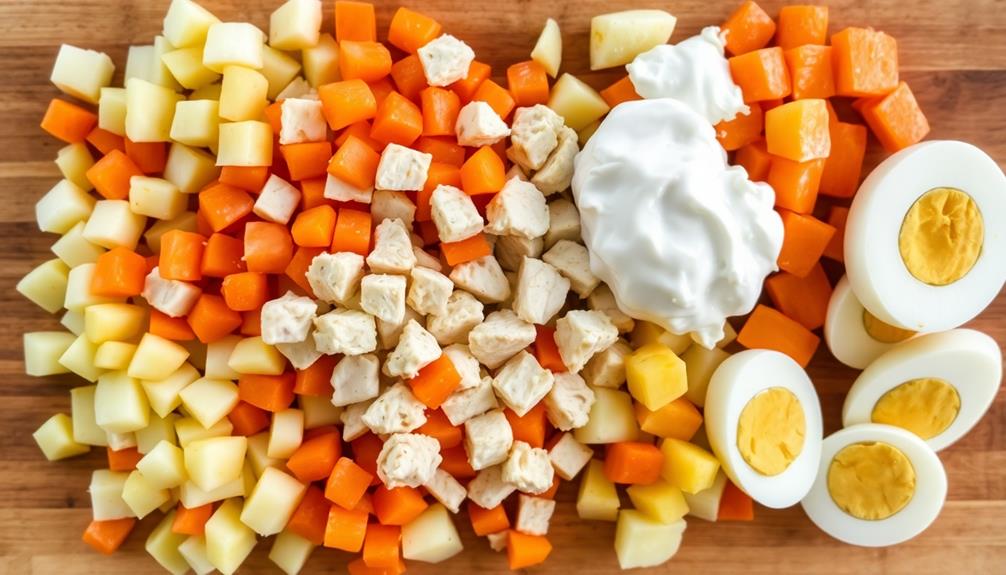
Gather and prepare the remaining vegetables for the Russian salad. Dice the carrots, cucumbers, and bell peppers into small, even pieces, about 1/2 inch in size. Slice the radishes thinly, creating delicate rounds. Chop the green onions, including both the white and green parts, into small pieces.
Combine all the chopped and sliced vegetables in a large mixing bowl.
Next, add the canned peas and corn kernels. Gently mix all the vegetables together, being careful not to mash or break them. This vibrant combination of colors and textures will create a visually appealing and flavorful Russian salad.
Remember to season the salad with salt and pepper to taste, adjusting the seasonings as needed. The fresh, crunchy vegetables will provide a delightful contrast to the boiled and peeled potatoes you prepared earlier.
Get ready to assemble the complete Russian salad!
Step 3. Dress Vegetables With Mayonnaise Mixture
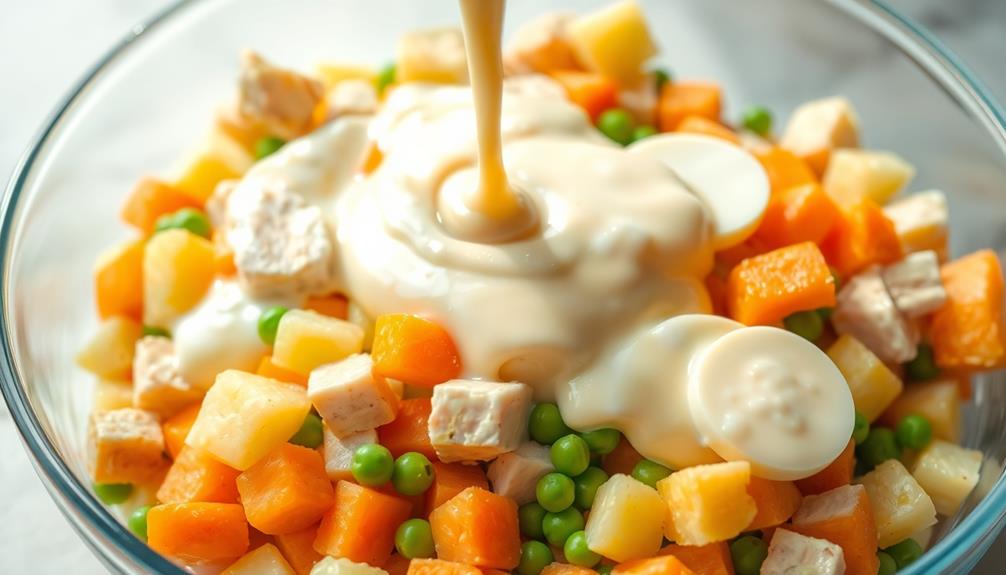
Now that you have combined all the chopped and sliced vegetables, it's time to dress them with a creamy mayonnaise mixture. In a small bowl, whisk together mayonnaise, sour cream, lemon juice, and a pinch of salt and pepper. The mayonnaise provides a rich, tangy flavor, while the sour cream gives the dressing a smooth, velvety texture.
The lemon juice adds a bright, refreshing note to balance the richness. Drizzle the mayonnaise mixture over the vegetables and gently toss to coat everything evenly. Be sure to distribute the dressing throughout, ensuring each bite packs a flavorful punch.
The vegetables should be lightly coated, not drenched, allowing their natural flavors to shine through. Taste and adjust the seasoning as needed, adding more lemon juice for acidity or a touch more salt for balance. Once the flavors are just right, your Russian Salad is ready to serve and enjoy!
Step 4. Add Seasoning
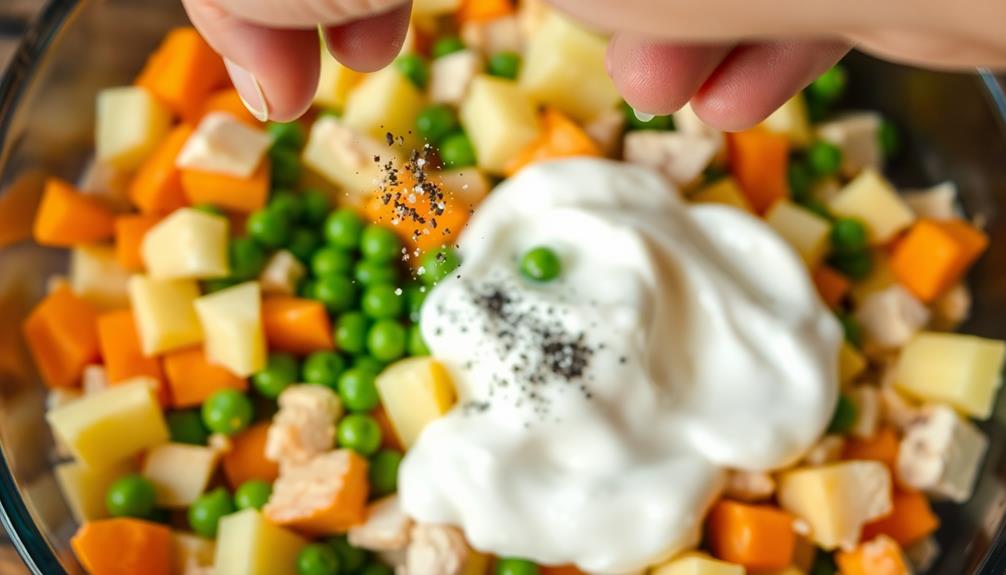
To balance the flavors and elevate the salad, add a sprinkle of salt and a grinding of black pepper over the dressed vegetables. This simple seasoning brings out the natural sweetness of the veggies and complements the creamy mayonnaise.
Next, give the salad a gentle toss, ensuring the seasoning is evenly distributed. You can also add a pinch of dried dill or a squeeze of lemon juice to brighten the flavors.
Taste the salad and adjust the seasoning as needed, adding more salt or pepper to suit your preferences.
For a touch of color and herbal freshness, consider sprinkling in some finely chopped parsley or chives just before serving. This adds a vibrant, festive element to the dish.
Step 5. Chill Before Serving
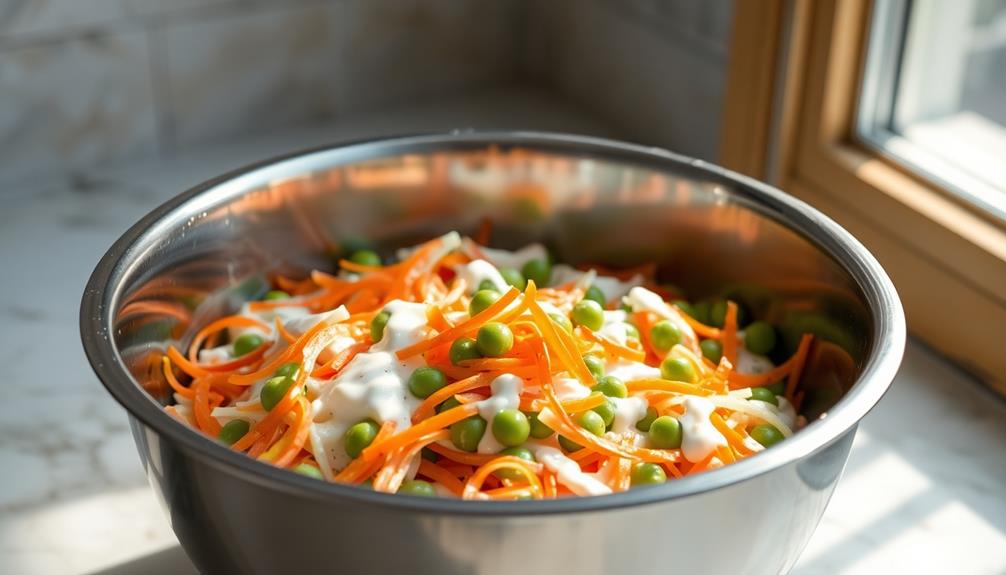
Once the salad is seasoned, it's important to chill it before serving. This allows the flavors to meld together and the vegetables to become nice and crisp.
Simply cover the bowl and pop it in the fridge for at least 30 minutes, but you can leave it in there for up to a few hours.
The colder temperature helps the ingredients firm up and come together. When you're ready to serve, give the salad a good stir to redistribute the dressing.
You'll notice the vibrant colors of the vegetables and the creamy dressing have blended beautifully. Taste and adjust any seasonings if needed.
Chilling the salad is the final step before enjoying this refreshing and flavorful dish. The wait will be worth it – your friends and family will love digging into this perfectly chilled Russian salad. Enjoy!
Final Thoughts
The Russian salad's captivating blend of flavors and textures has left an indelible mark on culinary traditions across the globe. Whether served as a side dish, main course, or even a festive appetizer, this versatile creation continues to delight and inspire food enthusiasts worldwide. Incorporating a mix of creamy potatoes, crisp vegetables, tangy pickles, and savory meats, the Russian salad offers a satisfying medley of tastes and mouthwatering satisfaction. Its popularity has even led to creative variations, such as adding different seasonings or substituting ingredients to suit individual preferences. Whether enjoyed at a casual family gathering or a formal celebration, the Russian salad has solidified its place as a beloved dish. And for those with a sweet tooth, it pairs perfectly with a delicious churros recipe for a well-rounded and satisfying meal.
As you savor the final bites, reflect on the rich history and cultural significance that this salad embodies. Its unique combination of crisp vegetables, tangy dressing, and unexpected ingredients like boiled eggs or canned peas, creates a symphony of tastes that dance on the palate.
As you cherish the final moments, remember that the Russian salad is more than just a dish – it's a culinary legacy that has stood the test of time, connecting people and cultures through the universal language of food.
Embrace its captivating charm, and carry on the tradition of sharing this beloved salad with family and friends.
Frequently Asked Questions
Is Ensaladilla Rusa a Traditional Spanish Dish?
Yes, ensaladilla rusa is a traditional Spanish dish. It's a classic salad made with boiled potatoes, vegetables, and a creamy dressing, and it's a staple in Spanish cuisine.
What Is the Difference Between Ensaladilla Rusa and Regular Potato Salad?
The main difference between regular potato salad and ensaladilla rusa is that the latter includes a variety of cooked vegetables, such as carrots and peas, in addition to potatoes. It also typically features a mayonnaise-based dressing.
Can Ensaladilla Rusa Be Made Vegetarian or Vegan?
Yes, you can make a vegetarian or vegan version of this dish. Simply omit the typical ingredients like tuna, eggs, or mayonnaise and substitute them with plant-based alternatives to create a delicious meatless version.
How Long Does Ensaladilla Rusa Last in the Refrigerator?
When kept properly refrigerated, your dish can typically last 3-4 days. Be sure to store it in an airtight container and consume it within that timeframe for the best quality and safety.
Can Ensaladilla Rusa Be Served as a Main Dish or Only as a Side?
Ensaladilla rusa can be served as either a main dish or a side. It's a versatile dish that can be enjoyed on its own or as an accompaniment to other meals. You can choose how to incorporate it into your dining experience.



